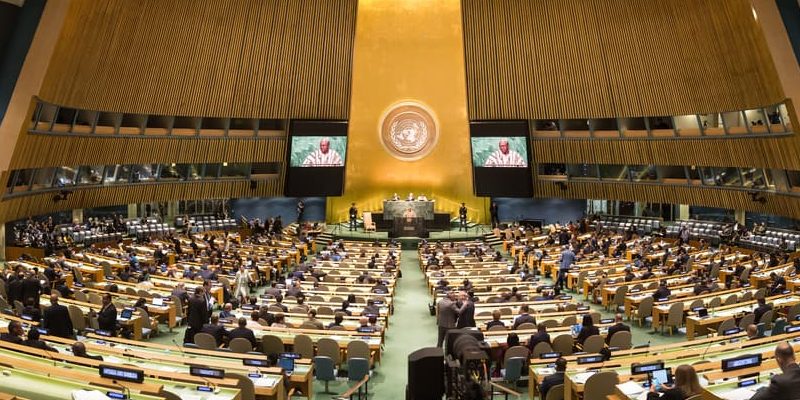We explain what public international law is, its principles and other characteristics. Furthermore, private international law.

What is public international law?
Public international law is the branch of law that deals with international relations between States and international subjects. It is the legal framework by which the international community is governed, in order to guarantee peace and the fair resolution of conflicts that may arise from their mutual relations.
In this fundamental perspective it is distinguished from private international law. Unlike other branches of law, public international law deals with legally mediating between sovereign entities.
Consequently, it does not consist of a coercive legal order, as occurs with the legal apparatus within each specific country. On the contrary, it is mainly coordinative, that is, it seeks to conduct the conflict through regular, peaceful and fair channels.
So, makes possible the construction of regulations accepted by all participating States and to which they voluntarily agree to submit. These norms could even have supraconstitutional status, as is the case of Fundamental Human Rights.
History of public international law
Since ancient times, war has existed between different nations and human civilizations, in their struggle to control resources or to expand their cultures and religions. However, in most conflicts in history there was some type of minimal legal order.
It could be informal or based on custom, governing “normal” behaviors in a confrontation and those considered abominable. In fact, by appealing to this type of rules, often of religious origin, peace was achieved between warring empires or at least the terms of some form of honorable surrender were agreed.
The oldest treaty of this type comes from Mesopotamian antiquity and involves the Chaldean cities Lagash and Umma around 3200 BC. C. This treaty would have allowed them to fix their borders at the end of a war.
Instead, The first modern case of this type of international legal instance was the Alabama Claims at the end of the American Civil War, which was tried by a court in Geneva.
However, as often happens, there is disagreement among the authors regarding the specific origin of Public International Law. Some consider it as old as human nations themselves, who agreed on terms to trade or exchange primitive goods.
On the contrary, other authors assume its formal beginning from the 16th or 17th century, when sovereign nations formally appeared willing to relate to others in terms of legal equality, as occurred in 1648 with the Treaties of Westphalia.
Sources of international public law
International public law has as its sources the diverse and varied treaties signed by States bilaterally or multilaterally such as pacts, agreements, memorandums, joint declarations, etc., as well as the so-called international custom, recognized in practice by States and by general principles of law.
To this we must add the legal documents emanating from international courts and multilateral legal organizations (such as the UN) that serve as a mediator in local and regional conflicts, providing a legal framework of mutual understanding between disputing nations.
Subjects of public international law

The subjects of public international law are:
- The national states duly recognized by their peers and by the international community as such.
- International Organizations mediation and international agreement, such as the United Nations, the International Labor Organization, etc.
- The belligerent community and the national liberation movements, in certain cases where they are recognized as political and not criminal actors.
- The physical person as a passive subject of international law, since it receives obligations and rights from it.
Characteristics of public international law
Public international law is based on the agreement that relations between nations must be for mutual benefit, and that they are always preferable to war.
Said relations of cooperation, rivalry or exchange must therefore be governed by voluntary treaties to which all countries that sign them must submit, considering that said order is independent of who exercises their governments.
The instances of public international law, thus, are decentralized and minimally coercive, dynamic bodies and endowed with a certain relativity with respect to international legal duties, that is, they can always be negotiated and subject to political work.
Principles of public international law
The principles of public international law uphold, above all, the right to sovereignty of nations. This means that by agreeing with other countries or signing international treaties they are not sacrificing their legal autonomy and self-determination, but rather agreeing to a space for international mediation that allows mutual agreements to be reached.
For this reason, many authors question the legal nature of this branch of law, since, in principle, there is no international body from which international laws emanate and that can coerce States to comply with them, but rather these will be the fruit of the voluntary agreement of nations.
Other fundamental precepts of contemporary Public International Law are:
- The “right” to war Just as there are laws of peace, there are also laws that govern what is acceptable in a situation of war, and that legitimize the use of armed force by one State against another. These conditions are three: in defense of one's own national security, at the service of a multilateral collective security mission or “peace force” by an international organization such as the United Nations, or when it is done at the service of some regional authority. in charge of ensuring peace.
- The treatment of foreigners The law that dictates respect for embassies, consulates and diplomatic representations of different types, which provide services to their compatriots on foreign soil, and which can mediate specific legal events regarding citizens of their nationality.
- Fundamental human rights Above any other treaty, the agreement on fundamental human rights and the punishment of those who violate them is one of the most universally accepted and defended precepts by international peace organizations.
Private international law
The two main branches of international law, public and private, differ from each other in that they are interested in international law from different points of view. Between them there is a distinction analogous to the one that exists within jurisprudence between private law and public law.
Private international law deals with the legal relationships of the populations of different countries. For its part, public international law deals with relations between different countries and States, such as territorial conflicts or disputes between their respective sovereignties.
Continue in: Private international law
References
- “Public International Law” on Wikipedia.
- “Public International Law” (video) at the UMNG Faculty of Distance Studies.
- “Public International Law” (video) at Rey Juan Carlos University (Spain).
- “Public international law. Functions, sources, compliance and the will of the states” (article) in Mexican Yearbook of International Law.
- “International Law” in The Encyclopaedia Britannica.





